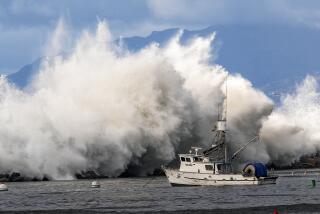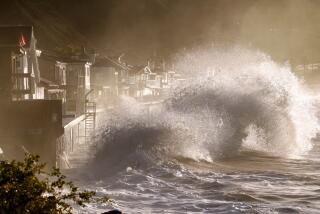Skepticism on El Nino Washed Away
So you still have doubts about El Nino?
What about the storm that raged through Southern California on Monday, claiming at least six lives, destroying and damaging scores of homes and severing several major highways and rail lines?
What about a winter in which twice the normal amount of rain has fallen throughout the state, and a February in which more rain has fallen on Los Angeles than during any other February on record?
The warnings came as early as last May, when the National Oceanographic and Atmospheric Administration noted, with little fanfare, that meteorological and oceanographic conditions in the tropical Pacific seemed to indicate that El Nino was on the way.
People started to take notice a month later when the agency’s top long-range forecaster, Ants Leetsmaa, said that come winter, Los Angeles could be pounded by storms rivaling those that wreaked havoc along the West Coast in the El Nino winter of 1982-83.
But as months of clement weather followed, a chorus of cynics voiced their doubts.
“If this El Nino gets much worse, I’m going to have to get stronger sun block,” comedian Willy Parsons chuckled in November.
As recently as Feb. 1, Times columnist Robert A. Jones sneered about “El Nino Desaparecido”--the disaster that had failed to materialize. Suffused with confidence, Jones even bet a meteorologist 10 bucks that El Nino would never show up, at least not this year.
Then, within hours, the rains arrived in earnest. And suddenly, all those people who had heeded the warnings and cleaned out storm channels, repaired roofs and shored up suspect hillsides looked pretty smart.
“The meteorologists who predicted all this are vindicated,” Mike Smith, a board-certified meteorologist who had stuck steadfastly to the forecast of a rainy winter, said Tuesday.
“The weather over the last three weeks has reflected a classic El Nino-related weather pattern,” said Smith, who is president of WeatherData Inc., a firm that provides forecasts for The Times.
“El Nino created an environment that made the storms more likely to form,” he said. “And it made them more intense.”
If the wise guys didn’t heed Leetsmaa’s warnings last summer, others did.
By mid-August, drains and flood channels were being cleaned, levees bolstered, trees chopped, evacuation plans reviewed and damage-control teams put through special training.
Utilities worked out mutual-aid pacts, firefighters polished their swift-water rescue tactics and cities like Malibu--seemingly hard-hit by almost every natural disaster--trained staff members in emergency procedures. In Long Beach and Seal Beach, sand berms were built to protect oceanfront homes.
Goevany Mora, owner of a roofing company in Canoga Park, reported in August that inquiries about roof repairs were 75% higher than usual. Rain-gutter installers said business had almost doubled. Building contractors put in early requests for sandbags to protect construction sites.
The possibility of pending disaster even became fashionable. Beverly Hills Armani’s latest chiaroscuro designs were crowned the “El Nino Collection.”
In October, the Federal Emergency Management Agency staged an El Nino Community Preparedness Summit in Santa Monica attended by Vice President Al Gore and a host of federal, state and local officials. FEMA urged homeowners to stockpile sandbags, buy flood insurance and prepare their homes to withstand heavy rains and runoff.
During the summit, officials took note of the bureaucratic tangle of state and federal agencies that were stalling efforts by the county Department of Public Works to clean out thickets of brush and trees that clogged several major flood control channels and river bottoms. The governmental tie-up eventually was unsnarled and the thickets were cleared.
But the season’s early rains were something of a letdown. It rained, all right, but, except for one heavy downpour during December, the rainfall was not much above normal.
Forecasters at WeatherData and the National Weather Service were hounded by skeptical reporters. Was El Nino a fraud?
Smith and his colleagues simply pointed to the winter of 1982-83, when the heaviest rains fell in February and March.
And sure enough, on Feb. 2 it started to rain--hard. It rained hard the next day, too, and after a brief break, it rained hard again on Feb. 6 and 7. A steady stream of northern Pacific storms--many of them intensified by tropical moisture drawn up from south of Hawaii--hammered Southern California for three weeks.
By nightfall Tuesday, 13.68 inches of rain had fallen at the Los Angeles Civic Center in February, enough to break the record of 13.37, set 114 years ago. While Los Angeles County has largely escaped destructive floods and mudslides, Orange County, Ventura County and dozens of counties to the north have not.
But officials say the damage probably would have been far greater were it not for the preparedness of homeowners and public agencies.
Val Bunting, a FEMA spokeswoman in Washington, said thousands of Californians received informational packets on ways to sandbag, trench and otherwise protect their homes, and although no figures are available, officials assume much of this information was put to good use.
Bunting said that after the preparedness summit, Californians purchased 50% more flood insurance than in previous years.
Donna Guyovich, a spokeswoman for the Department of Public Works, said that without the clearing of flood and river channels in Los Angeles County, “we could have had overflows, and nearby homes could have been damaged.”
Blair Barton of the state’s Office of Emergency Services said the rebuilding of protective berms and levees in the northern part of the state “made a big difference. . . . There was a lot of flooding prevented.”
But all the officials cautioned that the current El Nino is not over yet, and there’s a good chance of a lot more rain for the next month or so.
Jones hasn’t waited for that. He’s already paid off his bet.
More to Read
Sign up for Essential California
The most important California stories and recommendations in your inbox every morning.
You may occasionally receive promotional content from the Los Angeles Times.










